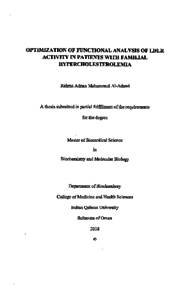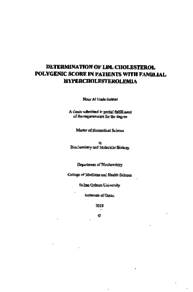وثيقة
Optimization of functional analysis of LDLR activity in patients with familial hypercholesterolemia
الناشر
Sultan Qaboos University
ميلادي
2018
اللغة
الأنجليزية
الملخص الإنجليزي
Introduction: Functional analysis of Low Density Lipoprotein Receptor (LDLR) activity is essential in understanding disease pathogenesis of familial hypercholesterolemia (FH) and understanding therapeutic response to lipid lowering agents. FH is a genetic disorder characterized by high blood LDL cholesterol levels (LDL-C). It is caused by a defect in the LDLR expression and/or internalization of LDL due to a mutation in the genes playing role in the LDLR mediated endocytosis, for instances LDLR, APOB, PCSK9, and LDLRAP1. These defects make the body unable to remove LDL from the circulating blood. Functional studies of LDLR activity helps in identifications of pathway involved in disease pathogenesis and helps in predicting response to therapy. The Lipid clinic in SQUH identified a group of definitive FH by clinical criteria but with no mutations detected in the four common genes: LDLR, APOB, PCSK9, and LDLRAP1.
Aim: To establish a method to investigate LDLR levels and uptake in patients with FH and unknown mutation and ultimately provide insight to target lipid-lowering therapy.
Method: Using flow cytometry, we carried out an optimization technique to measure LDLR expression and uptake in T-lymphocytes of three healthy controls, four FH patients with LDLR mutation (exon9, c.1319-1352 del p.R440fs), and three FH patients with negative pathogenic mutation in PCSK9, LDLR, APOB AND LDLRAP1 genes. In the LDLR expression, we treat the cells with 10ug/mL autoclaved Atorvastatin for 24h and incubate them with 1:133 of APC-LDLR Antibody for 20 minutes. In the LDL uptake, we incubate the cells with 10ug/mL LDL-fl Bodipy for three hours.
Results: Patients with LDLR p.R440fs mutation showed a good response to statin therapy as indicated by increase surface LDLR expression level and a mild increase in LDL uptake. Additionally, patients with negative mutations showed a modest response to statin as indicated by surface LDLR expression and LDL uptake.
Conclusion: The optimized method for testing the LDLR expression and uptake were successfully achieved. Additionally, p.R440fs mutation resulted in the detection of LDLR and a mild uptake due to lack of cytoplasmic domain of the receptor. Pathogenicity of elevated LDL-C in negative mutation could be explained by a defect in the genes involved in the LDL uptake such as regulators of apoB and clathrin.
الوصف
Thesis
المجموعة
URL المصدر
الملخص العربي
المقدمة: التحليل الوظيفي النشاط مستقبلات LDL ضروري لفهم مرض فرط كوليسترول الدم (FH) والذي يساعد على فهم استجابة المريض الأدوية خفض الدهون. FH هو اضطراب وراثي يتميز بارتفاع مستويات الكولسترول ( LDL - C ) والذي ينتج بسبب مشكلة في تصنيع مستقبل LDLR أو التخلص من LDLبسبب وجود طفرة في الجينات التي تلعب دورا هاما في دورة LDLR مثل 100-Ap0B و PCSK9 و LDLRAP1. هذه الطفرات تجعل الجسم غير قادر على إزالة LDL من الدم.
الهدف: إنشاء طريقة جيدة لدراسة نشاط LDLR في المرضى الذين يعانون من FH بدون معرفة الطفرة المسببة للمرض ، وبالتالي يمكننا من توفير العلاج المناسب لخفض الدهون
الطريقة: قمنا بإجراء تجرية لقياس تعبير LDLR في الخلايا الثانية في فئة مرضى FH مع طفرة LDLR c . 1319 - 1352 del p . R440fs exon9) ، ومرضى FH بدون وجود طفرة مكتشفة باستخدام التدفق الخلوي. ففي اختبار تعبيرال LDLR ، عالجنا الخلاياب ب ۱۰ ميكروجرام/ مل من Atorvastatin المعقم لمدة ٢٤ ساعة وصبغناها ب ۱: ۱۳۲ الجسم المضاد ل APC - LDLR ۲۰ دقيقفز أما في اختبار التخلص من LDL صبغناها ب ug۱۰ / مل LDL - FI Bodipy لمدة ثلاث ساعات.
النتائج المرضى الذين يعانون من الطفرات R440fs.ح تظهر استجابتهم جيدة في العلاج وزيادة معتدلة في أخذ LDL. بالإضافة إلى ذلك ، يظهر المرضى الذين يعانون من FH بدون وجود طفرة استجابة جيدة إلى الستاتین وزيادة في التخلص من LDL. جديد في العلاج وزيادية إلى فستان
الخلاصة: تمكنا من تحقيق الطريقة المثلى لإختبار تعبير LDLR,وامتصاصه إن الطفرة p . R440fs تنم عن خلل في LDLR والتخلص من LDL بسبب وجود نقص المجال السيتوبلازمي للمستقبل. و لتفسير سبب ارتفاع LDL - C في مرضی FH بدون وجود طفرة مكتشفة يعود إلى وجود خلل في الجينات المشاركة في التخلص من LDL مثل منظمات apoB و clathrins.
الهدف: إنشاء طريقة جيدة لدراسة نشاط LDLR في المرضى الذين يعانون من FH بدون معرفة الطفرة المسببة للمرض ، وبالتالي يمكننا من توفير العلاج المناسب لخفض الدهون
الطريقة: قمنا بإجراء تجرية لقياس تعبير LDLR في الخلايا الثانية في فئة مرضى FH مع طفرة LDLR c . 1319 - 1352 del p . R440fs exon9) ، ومرضى FH بدون وجود طفرة مكتشفة باستخدام التدفق الخلوي. ففي اختبار تعبيرال LDLR ، عالجنا الخلاياب ب ۱۰ ميكروجرام/ مل من Atorvastatin المعقم لمدة ٢٤ ساعة وصبغناها ب ۱: ۱۳۲ الجسم المضاد ل APC - LDLR ۲۰ دقيقفز أما في اختبار التخلص من LDL صبغناها ب ug۱۰ / مل LDL - FI Bodipy لمدة ثلاث ساعات.
النتائج المرضى الذين يعانون من الطفرات R440fs.ح تظهر استجابتهم جيدة في العلاج وزيادة معتدلة في أخذ LDL. بالإضافة إلى ذلك ، يظهر المرضى الذين يعانون من FH بدون وجود طفرة استجابة جيدة إلى الستاتین وزيادة في التخلص من LDL. جديد في العلاج وزيادية إلى فستان
الخلاصة: تمكنا من تحقيق الطريقة المثلى لإختبار تعبير LDLR,وامتصاصه إن الطفرة p . R440fs تنم عن خلل في LDLR والتخلص من LDL بسبب وجود نقص المجال السيتوبلازمي للمستقبل. و لتفسير سبب ارتفاع LDL - C في مرضی FH بدون وجود طفرة مكتشفة يعود إلى وجود خلل في الجينات المشاركة في التخلص من LDL مثل منظمات apoB و clathrins.
قالب العنصر
الرسائل والأطروحات الجامعية


